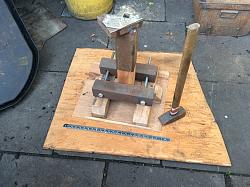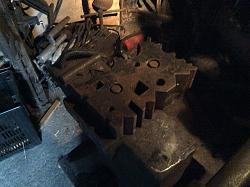Just as a nail header is used to forge the heads on nails, a heading anvil is used to upset (ie thicken) heavier stock in order to make anvil tools that are set, when needed, into the hardy hole.
Mark Aspery, in the first of his books on the fundamentals of forging, describes the process of making one, which I have followed fairly closely. I heartily recommend these books, as well as his YouTube videos. Their clarity and detailed instructions cannot be bettered.
While his has a square 1/2 thick plate forming the anvil, mine is an offcut o 1+1/4 plate, left over from the swage block I made. I did not bother to cut it into a square, hence the odd shape. Aspery did not write anything about hardening the plate, but since I anticipate distortion to the hole, I have riveted some scraps of gauge plate around it. The hardy hole is bolstered from beneath by a package of tubes, coldchisels etc, welded up to fit the box tube, which sits on a column of pitch pine. The base is beech, not ideal, since this is for outdoor use. But it breaks down easily into 4 components for storage. There are 2 iron weights, probably originally lift counterweights on top, to stop it bouncing about. It is 23 high.
Originally, I intended my swage block to bridge my anvil, and use it for heading.
But with limited headroom, I can only use a short handled sledge. Also its a bit too high. Making an anvil tool is a lot of sledging.


 LinkBack URL
LinkBack URL About LinkBacks
About LinkBacks




 Reply With Quote
Reply With Quote





Bookmarks